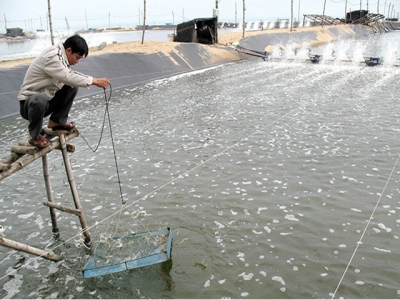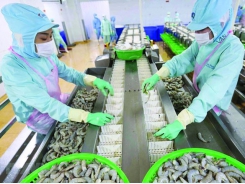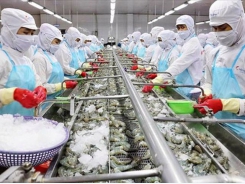Seafood exports on the decline

The fourth wave of Covid-19 made seafood enterprises wary about signing new export contracts because of concerns over congestion at ports and at border gates, especially with China tightening customs clearance procedures.
Due to the prolonged distance and lack of synchronous coordination among localities in the region when applying Directive 16, not only the shrimp industry supply chain is at risk of collapse, but other agricultural and aquatic products processing industries - The main economic sectors in the Mekong Delta region also suffered.
RISK OF LOSSING KEY EXPORT MARKET IN THE US
Minh Phu Seafood Group has long been considered the "shrimp king" of the West, with customers in over 50 countries and territories, annual revenue of over 10,000 billion VND. However, the implementation of the distance has greatly affected the shrimp supply chain of enterprises.
Sharing at the recent online conference "Promoting circulation and consumption of agricultural products in the context of Covid-19 prevention and control", Mr. Le Van Quang, Chairman of Minh Phu Seafood Group said, due to the distance, Due to the isolation, the supply of seed, feed, chemicals, microbiology and warranty service and repair of shrimp farming equipment was broken, so shrimp farmers were very miserable.
“Also because of the distance and isolation, there is no one to pull the net to harvest shrimp, as well as difficult to transport shrimp from the pond to the factory. So many shrimp ponds that cannot be harvested must be left to die white in shrimp ponds, very heartbreaking. Minh Phu has accelerated the freezing of IQF raw shrimp, but the cold storage is full, so it is not possible to freeze raw IQF shrimp anymore.
Mr. Le Van Quang, Chairman of Minh Phu Seafood Corporation.
“The biggest impact on the shrimp supply chain is that shrimp processing factories have to implement the "three-on-the-spot" production plan, so some factories cannot meet the requirements and have to close. The rest can only produce about 25-50% of capacity, with the production cost increasing by 70%, excluding the cost of raw shrimp, "said Mr. Quang.
Currently, many customers around the world of Minh Phu are urgently asking the company to provide signed orders in order to sell them in time for Christmas.
If the goods cannot be delivered, customers will leave to buy from India, Indonesia and Thailand, so Minh Phu will lose customers, lose the market that has worked hard to build for many years.
Also according to a representative of the Vietnam Food Association (VFA), currently, the progress of rice harvest is delayed, causing great losses to farmers. Besides, if it is harvested, it will also face many difficulties in transporting it to the processing plant for proper preservation and storage.
“With the characteristics of interlaced canals, the rice produced in the Mekong Delta is transported 95% by water, so the traffic congestion as in the past time has led to the risk of chain interruption. supplying rice and goods from the field to the export port", said a representative of VFA.
If the internal difficulties are not resolved in time, the industry turnover will certainly be affected and lead to the risk of losing export markets, especially traditional markets such as the Philippines, China, and Malaysia in the coming years. other competitors in the region, such as Thailand, India.
CLEARANCE OF CUSTOMS TIME, PUSHING COST
Not only domestic traffic, the situation of exporting goods through the border gate is also congested. According to statistics of the General Department of Vietnam Customs, in the first eight months of 2021, preliminary fruit and vegetable exports reached $2,497 million, up 10.7% over the same period in 2020. Of which, exports to the Chinese market reached 1,329 million USD, accounting for 58.02% of the market share. However, worryingly, there is a declining trend of exports to the Chinese market, since May the turnover has continuously decreased, an average of 15% per month.
Dang Phuc Nguyen, General Secretary of the Vietnam Fruit and Vegetable Association analyzed that the serious impact of the Covid epidemic forced us to apply the strongest prevention measures, making the production and circulation of goods. suffered from difficulties and disruptions in the supply chain of goods exported to the Chinese market.
Worryingly, in mid-July 2021, China suspended the import of dragon fruit at Hekou and Thien Bao border gates, in Yunnan province on the grounds that Vietnamese goods were suspected of being infected with the Covid virus.
“Although ministries, sectors and localities have actively worked with the Chinese side, such incidents continue to happen, causing considerable damage to the Vietnamese economy in general and to businesses in general. separately”, emphasized Mr. Nguyen.
At land border gates, from May 2021, because eight official export of Vietnam's vegetables and fruits have not previously been signed with an official Protocol on phytosanitary, so China has applied the inspection. The vegetable and fruit epidemic is stricter than before, with almost 100% of China's border-side shipments.
For example, in the past, a refrigerated truck of dragon fruit from the Vietnamese border to Guangxi Province only took 2-3 days, now it takes more than a week, making the transportation cost doubled, from 50 million/tank. to more than 100 million, causing a shortage of vehicles to turn around to carry goods.
Responding to the above information, the representative of the General Department of Customs said that due to the Covid-19 epidemic situation, the Chinese side has increased inspection and supervision of goods and means of transport crossing the border. For goods imported into China, they must be issued with a certificate of traceability by the Chinese Customs authority such as checking at the source, providing labels for products, affixing traceability stamps, etc.
In addition to a number of regulations according to international practices, such as inspection and disinfection of epidemic prevention for goods transported in normal containers, sterilization of the loading and unloading stages of goods on containers, etc., a representative of the General Department of Customs said. China also makes a number of separate requirements or tightens the implementation of previously issued regulations, such as designating import border gates, shortening the time to close and open border gates...
Therefore, import and export mainly take place at international border gates, main border gates. Some sub-border gates import-export activities decreased sharply, even without any activities such as Ma Lu Thang border gate (Dien Bien), Binh Nghi, Na Nua, Po Nhuan, Ba Son (Collar) border gates. Chac village (Lang Son)…
LOGISTICS NEED TO BE SUCCESSFUL, DO NOT CREATE BUSINESSES
To remove obstacles for circulation and avoid supply chain disruptions, Mr. Dang Phuc Nguyen suggested: "Create more favorable conditions for means of transport, to relieve congestion of products and goods from production areas. exported to places of consumption, to warehouses, factories, processing plants, production, and delivered to wharves and seaports for export”.
In addition, the front-line priority subjects need to increase the coverage of Covid-19 vaccines such as production workers, harvesting and packaging export goods, ensuring enough workers to operate and ensuring that goods are not infected with Covid when exporting to Vietnam. your country, avoid being boycotted or banned from entering.
Representatives of many business associations also suggested ministries, sectors and localities to ensure smooth logistics services and stable transportation rates. At the same time, studying feasible production organization options, helping to reduce the cost burden for businesses, and at the same time, helping employees have a comfortable spirit to work and maintain a stable labor source in the future. manufacture.
Facing the situation of some shortcomings and limitations at the quarantine checkpoints of some localities on inter-commune and inter-village roads and agricultural product purchasing points, the Ministry of Transport has sent a written request to the Department of Transport. Transport of provinces and centrally-run cities shall assume the prime responsibility for, and coordinate with the Department of Agriculture and Rural Development, the Department of Industry and Trade, the Department of Health and the People's Committees of districts, towns and relevant functional agencies of the province. Unify the location of the checkpoints, the process and the operating model of the epidemic control checkpoints, in order to strictly control the starting and ending points in the supply chain, and at the same time, ensuring strict implementation of the regulations of the Ministry of Health. Medican.
In particular, it is necessary to grasp the principle of smooth traffic. All goods are necessary except prohibited goods. All transport routes are green channels. Priority will be given to vehicles with vehicle identification papers, only strengthening pre-inspection and post-inspection at the places of goods delivery and receipt. If the vehicle does not have an identification certificate, the inspection will be organized accordingly, but absolutely no traffic jams will occur during the inspection process.
Currently, the Ministry of Transport is also developing a detailed plan to gradually return to intra-provincial and inter-provincial passenger transport for each type of transport, including road, air, railway, maritime, and road. inland waterways corresponding to each epidemic plan in the coming period for implementation and application.
Có thể bạn quan tâm
Phần mềm

Phối trộn thức ăn chăn nuôi

Pha dung dịch thủy canh

Định mức cho tôm ăn

Phối trộn phân bón NPK

Xác định tỷ lệ tôm sống

Chuyển đổi đơn vị phân bón

Xác định công suất sục khí

Chuyển đổi đơn vị tôm

Tính diện tích nhà kính

Tính thể tích ao hồ



 New long-term strategy needed for pangasius industry
New long-term strategy needed for pangasius industry  Seafood processors in difficult spot
Seafood processors in difficult spot